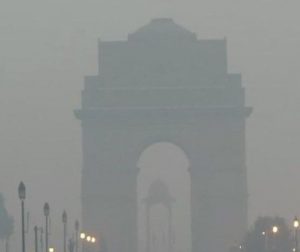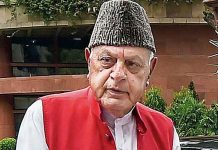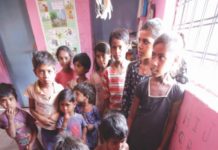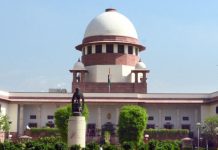 Jatin, 32, is tensed as his wife has warned him of leaving him permanently if he doesn’t leave Delhi by November. The reason is Jatin’s wife had suffered from TB last year and the return of Delhi’s abysmal pollution level is giving them nightmares. “We are not able to breath even inside our house due to smell of smog and odour from the garbage dump in Ghazipur. My wife can’t survive here,” says Jatin, who is currently living in Anand Vihar.
Jatin, 32, is tensed as his wife has warned him of leaving him permanently if he doesn’t leave Delhi by November. The reason is Jatin’s wife had suffered from TB last year and the return of Delhi’s abysmal pollution level is giving them nightmares. “We are not able to breath even inside our house due to smell of smog and odour from the garbage dump in Ghazipur. My wife can’t survive here,” says Jatin, who is currently living in Anand Vihar.
With the onset of autumn, the air quality index (AQI) of Delhi and national capital region (NCR) dropped drastically, causing numerous health inconveniences to its citizens. In fact, many Delhizens have complained of respiratory problems like heavy breathing, toxic smells, burning sensation in eyes and nose due to the spike in the air pollution level. Post the Diwali festival, the air quality, which was fluctuating between “poor” and “very poor” in October would now aggravate further from November due to change in the weather conditions and industrial construction. Adding more woes to the pollution levels is the smoke coming from the neighbouring states of Punjab and Haryana due to crop stubble burning, which takes place every year during the winter season.
Notably, an AQI between 0 and 50 is considered ‘good’, 51 and 100 ‘satisfactory’, 101 and 200 ‘moderate’, 201 and 300 ‘poor’, 301 and 400 ‘very poor’, and 401 and 500 ‘severe’. Earlier, a study released in September by the Centre for Science and Environment (CSE), showed that the air pollution level in Delhi dropped by 25 per cent, which was lowest in the past three years. “The analysis of annual air quality data submitted by the Central Pollution Control Board (CPCB) to the Parliament shows that the three-year average of PM2.5 levels during 2016-2018 is 25 per cent lower than the 2011-2014 baseline (three-year average),” reads the study.
The politics on the air pollution soon began after the study was out when both AAP and BJP came forth to claim credit for 25 per cent reduction in the pollution level by listing out initiatives from their past records. Though the parties since then have made Delhi air pollution a part of their speeches, but not without attacking each other.
Taking a dig at the anti-pollution body CPCB recently, the AAP had asked the apex body to “take a leaf out” of Delhi Chief Minister Arvind Kejriwal’s book on how to tackle pollution in cities like Varanasi. “I am sure the CPCB’s concerns are at par if not more for the people of Varanasi as for the people of Delhi and you will find it timely to hold the erring parties accountable,” said Raghav Chadha, spokesperson, AAP.
BJP leader Vijay Goel who blames Arvind Kejriwal for the deteriorating quality of air in Delhi said that it is the central government which has taken important steps to combat air pollution. “The centre has made national highways, bridges and also allocated Rs. 11,000 crore for the farmers, who were burning stubble in Punjab and Haryana,” said Goel.
Delhi is approaching the assembly elections, scheduled in February next year and the political parties are making earnest effort to win the voters over the idea of clean air. The issue of air pollution is definitely one of the key agendas for the political parties in the assembly polls, however, both the parties overlook the fact that Delhi still faces the “daunting challenge of 65 per cent reduction from the current baseline to meet the clean air standards for PM2.5,” according to a report released by CSE. Delhi Chief Minister Arvind Kejriwal has said that stubble burning is the major factor behind the spike in air pollution in the Capital. “Till pollution from outside is not solved, Delhi will suffer like this in October and November.” However, as per the report of CSE, stubble burning contributes only about 5-7 per cent to Delhi’s pollution. More than the smokes blowing from Punjab and Haryana, the local sources are real aggravators of pollution, it said.
Tackling pollution
“It’s not enough to have outrage against the pollution. We must be angry because it effects our health. It effects the health of our children. But, we must also demand action,” urged Sunita Narain, Director General of CSE in a recent video report. CSE report said Delhi needs more broad-based and stronger action at regional level with stringent compliance to prevent winter pollution from worsening.
In September, Kejriwal had announced a seven-point action plan for Delhi to reduce air pollution including free distribution of anti-pollution masks and implementation of the odd-even scheme which will begin from November 4-15. Beside, the AAP has taken initiatives like appointing of two environment marshals to dissuade people from burning garbage during winters, monitoring of hotspots of pollution and start a helpline number for environment lovers willing to plant trees in their locality.
In another move, Delhi Cabinet also approved an expenditure of Rs 36 crore from the budget of the Directorate of Information and Publicity for carrying out mass awareness campaigns against pollution in the national capital.
In January 2019, the BJP government had launched National Clean Air Programme (NCAP) to reduce particulate matter (PM) pollution by 20-30 per cent in all 102 cities, including Delhi, that exceed national air quality safeguards by 2024. Then the Congress, earlier this year, in its manifesto also mentioned about a scheme to tackle air pollution. “We will significantly strengthen the National Clean Air Program in order to urgently tackle the problem of pollution. All major sources of emission will be targeted, mitigated and reduced to acceptable levels,” the manifesto read.
Other measures like shutting down of thermal power plants, prohibition on use of fuel such as pet coke, furnace oil, coal, switching to BSVI fuel vehicles, restricting the entry of 10-year-old trucks in the Capital and NCR have helped curb the air pollution in the last eight months. But it’s tough to say which political party deserves the credit as it seems both the centre and state have contributed to some extent to pollution control. It would be interesting to see how these parties would perform in the upcoming assembly polls while making air pollution as one of the key political issues.
letters@tehelka.com













